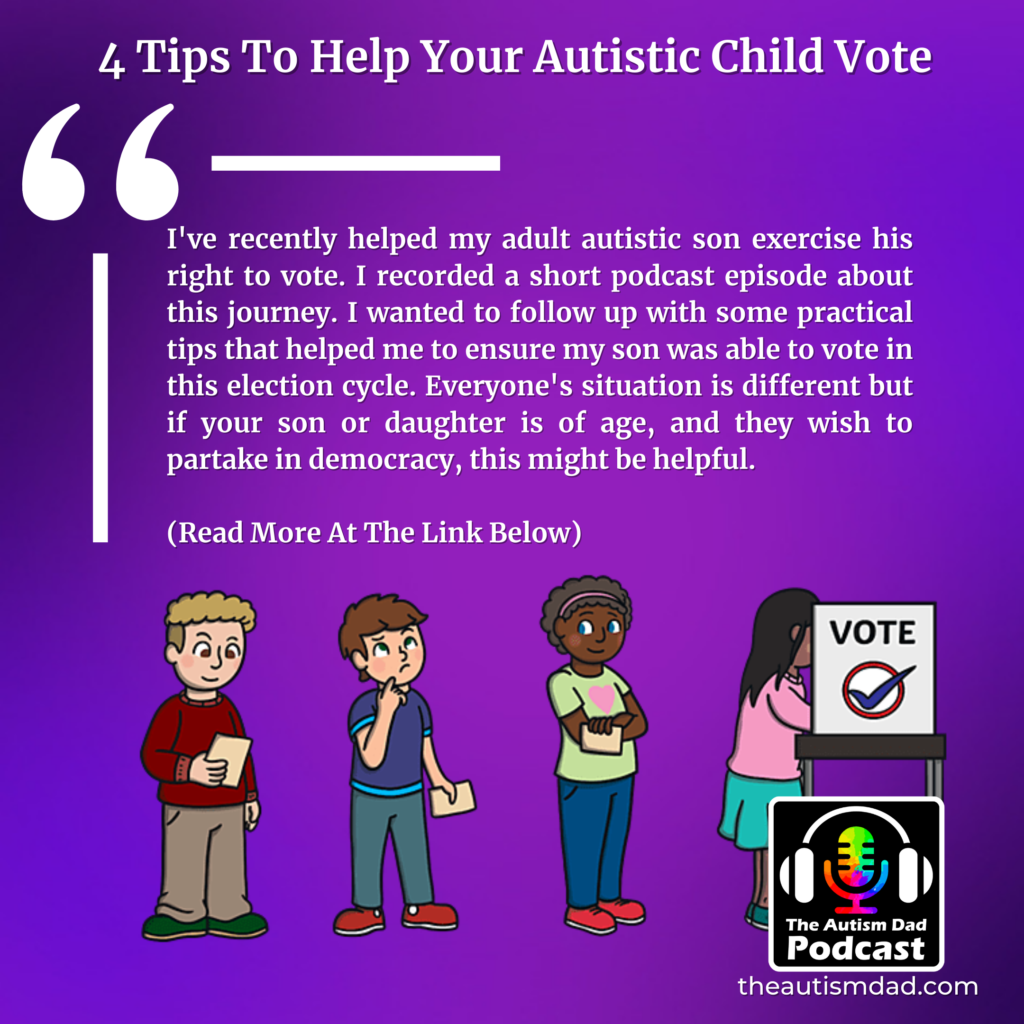I’ve recently helped my adult autistic son exercise his right to vote. I recorded a short podcast episode about this journey, and it’s embedded below. I wanted to follow up with some practical tips that helped me to ensure my son was able to vote in this election cycle. Everyone’s situation is different, but if your son or daughter is of age and they wish to partake in democracy, this might be helpful.
It’s important to remember that people with disabilities, including autism, have the right to vote. However, voting can be a complicated process, and some people with autism may need assistance to exercise their right to vote.

Register to Vote
The first step in the voting process is registering to vote. In most states, this can be done online, by mail, or in person at your local county clerk’s office. If your son or daughter is not already registered to vote, help them fill out the necessary paperwork and submit it according to the instructions. They may need a state-issued ID in order to cast their ballot. If they don’t already have an ID, they can get that at their local BMV and register to vote simultaneously. My son used this method to register.
In most states, this can be done online, by mail, or in person at your local county clerk’s office. If your son or daughter is not already registered to vote, help them fill out the necessary paperwork and submit it according to the instructions.
Know the Voting Options
There are several different ways to vote, including in person on election day, early in person at your local polls, by mail, or absentee. Help your son or daughter research the different options and decide which one will work best for them. Some people may do better or feel more comfortable voting from home, and that’s okay. These options exist for a reason, and they have every right to take full advantage of whichever option best meets their needs. Once they have decided how they want to vote, make sure they have all the necessary materials and information (e.g., as mentioned above, a valid ID if they plan to vote in person).
Make a Plan To Vote
Voting can be a complex process, so it’s important to make a plan ahead of time. For example, if your son or daughter plans to vote by mail, make sure they understand when they need to request a ballot and when it needs to be postmarked. That can be found online. If they plan to vote early in person or on election day, help them map out where their polling place is and what time they need to go. Planning ahead will help reduce stress on election day and make sure your son or daughter’s vote is counted.
Things to Think About
Being an informed voter is really important. Help them to find resources they can use to learn about the candidates, as well as any issues on the ballot. Give them a safe space to ask questions and talk about their opinions. They have the right to their thoughts, feelings, and opinions. There’s nothing wrong with challenging them on their views, but it’s important to ultimately respect their views, even if you don’t agree.
You could make voting a family ordeal, and everyone can ride together. In other situations, they may need to arrange transportation. Typically, there are local agencies that can assist with transporting people to and from the polls.
Something else to think about is suggesting they practice their signature. They will need to sign their name, and it will need to match the sample on file. This is important because if their signature doesn’t match, their vote may be discarded. Practicing can help to avoid issues on voting day.
Conclusion:
Voting is an important right that all citizens have—including those with autism. These tips can help you assist your young voter cast their ballot.
Registering to vote, knowing the different voting options available, making a plan ahead of time, and keeping a few things in mind, will help ensure that the process goes as smoothly as possible so your son or daughter’s voice is heard on election day.

